August 1-14, 2001
The Big Travelogue: Part Two
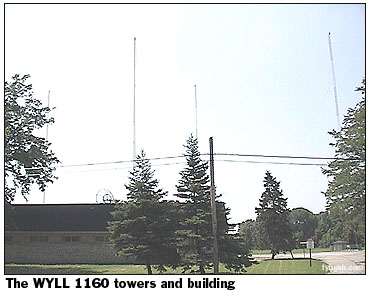 There's nothing like
a good road trip to get a feel for the state of radio these days.
From June 23 until July 7, your editor (accompanied by Boston
Radio Archives creator Garrett Wollman) hit the road to see what's
on - and in - the air across a broad swath of mid-America. There's nothing like
a good road trip to get a feel for the state of radio these days.
From June 23 until July 7, your editor (accompanied by Boston
Radio Archives creator Garrett Wollman) hit the road to see what's
on - and in - the air across a broad swath of mid-America.
For the next few installments of Site of the Week, we'll be
recapping the many highlights of what we like to think of as
The Big Trip, 2001 edition. Come along...
Click
here for part one
Monday, June 24 - Having seen a few of the important
sites within Chicago city limits on the north side, we're off
to the suburbs, working our way north to south past some of the
biggest signals the midwest has to offer.
First stop: just off the Tri-State Tollway at US 14 in Des
Plaines, where it's easy to spot the four towers in a parallelogram
off to the northeast of the intersection. After a few false turns
behind a nursing home, we make our way to Ballard Avenue and
the view you see above. This is the AM 1160 that's licensed to
Chicago, and for years it was WJJD, pumping out adult standards.
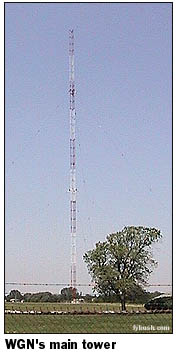 WJJD
died a few years ago, replaced by WSCR, "the Score,"
Infinity's all-sports entry. WSCR began life on the 820 kHz daytimer
we saw in the previous installment, but the move to 1160 gave
it a 24-hour signal for the first time. Unfortunately, it's a
24-hour signal built on a station that began as a daytimer, and
the need to protect KSL in Salt Lake City and other 1160 outlets
meant WSCR didn't reach the western suburbs after dark. WJJD
died a few years ago, replaced by WSCR, "the Score,"
Infinity's all-sports entry. WSCR began life on the 820 kHz daytimer
we saw in the previous installment, but the move to 1160 gave
it a 24-hour signal for the first time. Unfortunately, it's a
24-hour signal built on a station that began as a daytimer, and
the need to protect KSL in Salt Lake City and other 1160 outlets
meant WSCR didn't reach the western suburbs after dark.
What's more, the Infinity-Westinghouse-CBS mergers put the
company over its limit of stations in Chicago, and with the huge
670 and 780 signals also in the cluster, 1160 went up for sale.
WSCR's format moved to 670, the old WMAQ, last August (more on
that in a bit), and 1160 spent a few months simulcasting WXRT-FM
(93.1) as WXRT(AM) before being sold to Salem, which moved the
religious talk format of WYLL-FM (106.7 Des Plaines) to 1160
as WYLL(AM).
From WYLL, it's south past O'Hare Airport and then northwest
on I-290 to visit two stations that everyone has
heard at one time or another. From the Rohlwing Road exit, it's
just a mile to the transmitter of WGN (720) in Elk Grove Village.
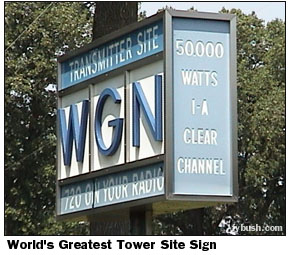 If
you're flying into O'Hare from the west, you know this is WGN,
thanks to big white letters that read "WGN" on the
lawn south of the tower. If you drive up to the majestic transmitter
building, you also know this is WGN, thanks to the neatest sign
I have ever seen at a transmitter site. If
you're flying into O'Hare from the west, you know this is WGN,
thanks to big white letters that read "WGN" on the
lawn south of the tower. If you drive up to the majestic transmitter
building, you also know this is WGN, thanks to the neatest sign
I have ever seen at a transmitter site.
WGN, like its clear-channel counterparts in Chicago, has two
towers: the main half-wave guyed tower shown above, along with
a shorter stick to the south (out of frame to the left) that
can be used as a backup facility.
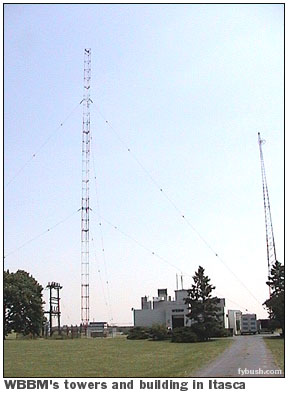
Follow Rohlwing Road south for two miles or so and you'll
be in front of another legendary Chicago station.
WBBM began its life on the lakefront at the old Broadmoor
Hotel (hence one explanation for the calls: "We Broadcast
Broadmoor Music"), but it's used this site since 1940 or
so.
Here, too, we find a big square-faced tower and a shorter
self-supporting backup. If you've received a QSL from WBBM in
recent years, you've learned that this short tower is used any
time there's lightning in the forecast. The big tower is shunted
to ground, creating the world's tallest lightning rod!
One more bit of WBBM trivia: In the twenties and thirties,
WBBM was synchronized with KFAB in Lincoln, Nebraska, which shared
its 770 kHz dial position. At night, both stations simulcast
CBS network programming, splitting apart in daylight hours. After
1941 and WBBM's move to 780, KFAB negotiated a frequency swap
in Nebraska, taking the 1110 kHz full-time channel that would
have gone to WJAG in Norfolk, Nebraska (and moving from Lincoln
to Omaha in the process). WJAG became a daytimer on 780; we'll
see it later in the trip!
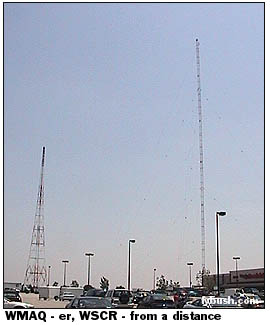 Down
I-290 south to I-355, we exit just before the toll, heading west
on Army Trail Road into Bloomingdale. Just off the south side
of this busy suburban road sits the very best AM signal in the
Windy City: the 670 kHz facility known for so many years as WMAQ. Down
I-290 south to I-355, we exit just before the toll, heading west
on Army Trail Road into Bloomingdale. Just off the south side
of this busy suburban road sits the very best AM signal in the
Windy City: the 670 kHz facility known for so many years as WMAQ.
This was the Chicago Daily News outlet in the
twenties and early thirties, before becoming the NBC Red Network
flagship for the midwest, originating shows that included Amos
and Andy. WMAQ remained an NBC owned-and-operated powerhouse
for decades, until GE sold NBC Radio in the late eighties.
WMAQ was spun off to Westinghouse, which turned the mighty
signal all-news in competition with WBBM - until that fateful
day in the mid-nineties when Westinghouse bought CBS, setting
the wheels in motion for the demise of the weaker all-news outlet,
WMAQ.
It happened in August of last year, as WMAQ breathed its last
and all-sports WSCR moved again, landing on this monster signal
that can be heard during the day across most of Iowa!
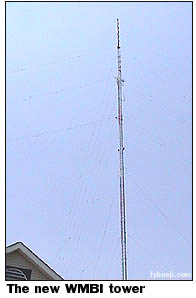 The old NBC brick
transmitter building is largely hidden by bushes and ivy, but
a careful peek through the fence reveals "W M A Q"
letters stil displayed above the door. Off to the side of the
building is a promotional van for "Y108," the old WYSY
(107.9 Aurora), which moved its antenna from a site out near
Aurora to the top of the 670 tower a decade or so ago. After
a few years as a 70s-pop station, WYSY was sold and became Spanish
WLEY, "La Ley," still with its antenna atop this tower. The old NBC brick
transmitter building is largely hidden by bushes and ivy, but
a careful peek through the fence reveals "W M A Q"
letters stil displayed above the door. Off to the side of the
building is a promotional van for "Y108," the old WYSY
(107.9 Aurora), which moved its antenna from a site out near
Aurora to the top of the 670 tower a decade or so ago. After
a few years as a 70s-pop station, WYSY was sold and became Spanish
WLEY, "La Ley," still with its antenna atop this tower.
Drive east on Army Trail from this site, across I-355, and
you're in Addison, home of the Moody Bible Institute's WMBI (1110)
and WMBI-FM (90.1). They used to operate from a massive old tower
on a big piece of land at Army Trail and Mill Road, with the
transmitter in the back room of someone's house, but the land
became too expensive and most of it was sold off. Today, you'll
find the new WMBI tower next to an anonymous brick shack at the
end of a cul-de-sac housing development!
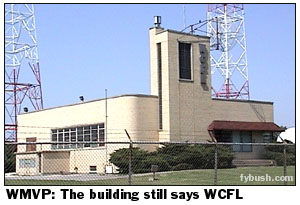 A stop for lunch,
and we're on to the next exciting Chicago signal. The AM 1000
spot on the dial was long known as WCFL, the Chicago Federation
of Labor's "Voice of Labor." A stop for lunch,
and we're on to the next exciting Chicago signal. The AM 1000
spot on the dial was long known as WCFL, the Chicago Federation
of Labor's "Voice of Labor."
But it wasn't just union politics; in the sixties and seventies,
CFL gave top-40 powerhouse WLS a serious run for its money, helped
along by jocks like the legendary Larry Lujack.
By the mid-eighties, WCFL had changed beyond recognition,
becoming a religious station with studios out here at the transmitter
site in west suburban Downers Grove, then getting sold to rocker
WLUP (97.9) and being reincarnated as talker WLUP(AM).
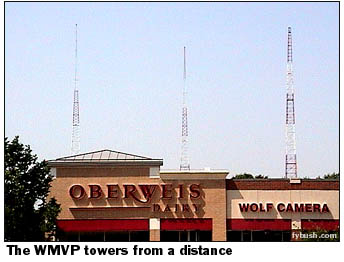 Another
format change took AM 1000 all-sports as WMVP, and a few years
ago, it was sold to Disney/ABC to become the Chicago signal for
ESPN Radio. Today it's simply "ESPN Radio 1000," with
the calls relegated to a quick hourly ID. Another
format change took AM 1000 all-sports as WMVP, and a few years
ago, it was sold to Disney/ABC to become the Chicago signal for
ESPN Radio. Today it's simply "ESPN Radio 1000," with
the calls relegated to a quick hourly ID.
The three big self-supporting towers, the old transmitter
building and a newer office building all sit on 39th Street between
Williams and Cumnor, a few short blocks north of busy US 34 in
the midst of an upscale residential neighborhood. In the fenced
parking lot, we spotted a van painted with the logo of the old
WTAQ (1300 LaGrange), one of Chicago's first Spanish-language
signals. More recently, 1300 has been another Disney/ABC property,
cranking out the kid stuff as "Radio Disney" WRDZ.
One more note before we leave Downers Grove: The "Oberweis
Dairy" in the strip mall that's blocking part of our view
above turns out to be a really good place for ice cream, especially
with temperatures in the low 90s this day...
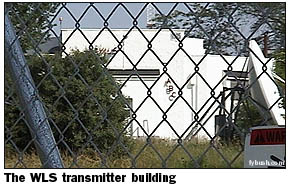 And
from there we head south, way south, to Tinley Park, hard by
the side of I-80 some 15 miles southeast of the Loop. Drive down
I-80 here and you can't miss the tall tower and its shorter counterpart
hugging the north side of the road a couple of miles west of
I-57. And
from there we head south, way south, to Tinley Park, hard by
the side of I-80 some 15 miles southeast of the Loop. Drive down
I-80 here and you can't miss the tall tower and its shorter counterpart
hugging the north side of the road a couple of miles west of
I-57.
This is the mighty WLS, the station that pretty much defined
top-40 for the midwest in the sixties just as its sister station
WABC did for the East Coast. Like WABC, WLS had the advantage
of a monster 50,000 watt nondirectional signal that traced its
heritage back to the heyday of network radio.
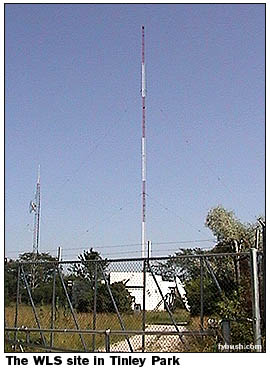 Unlike WABC, WLS
had a tangled history getting there. Up until the start of the
sixties, this was a share-time operation, with NBC Blue Network
midwestern flagship WENR handing off part of its airtime (first
on 870, then on 890 kHz) to WLS, the "Prairie Farmer"
station that targeted its programming to the heartland that stretches
for hundreds of miles south and west from Chicago. Unlike WABC, WLS
had a tangled history getting there. Up until the start of the
sixties, this was a share-time operation, with NBC Blue Network
midwestern flagship WENR handing off part of its airtime (first
on 870, then on 890 kHz) to WLS, the "Prairie Farmer"
station that targeted its programming to the heartland that stretches
for hundreds of miles south and west from Chicago.
ABC, the successor to the old Blue Network, finally consolidated
its ownership of 890 under the WLS calls around 1960, paving
the way for "Musicradio 89" and voices like John Records
Landecker to own the airwaves for more than a quarter of a century.
WLS hung on to music - in glorious AM stereo, even - for a
few years after WABC changed formats. By the late eighties, though,
WLS too had become a talker, and remains so to this day.
This site, while easy to see from I-80, is much harder to
reach by surface roads: it sits on a dead-end dirt portion of
183rd Street just west of 94th Avenue, just northeast of the
I-80/US 45 interchange.
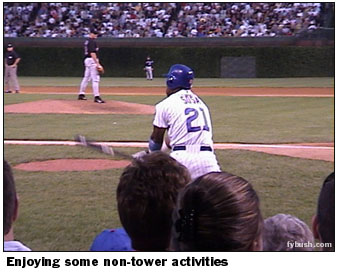 Returning downtown
(and marveling at the lack of traffic on the reverse commute
north up I-57), it's time to check out another sort of Chicago
powerhouse. Returning downtown
(and marveling at the lack of traffic on the reverse commute
north up I-57), it's time to check out another sort of Chicago
powerhouse.
Wrigley Field is packed, as usual, as we enjoy the Cubs defeating
the Mets - and in place of the late Harry Caray, the soon-to-be-cancelled
Bozo the Clown singing "Take Me Out to the Ball Game" from up in the WGN
radio/TV booth.
Talk about your Chicago institutions...
Tuesday, June 26 - Our final morning in Chicago finds
us checking a few more interesting sites off the list. In our
last installment, you might recall, we saw the remnants of the
defunct share-time operation on 1240 kHz. This time, we're checking
out the last share-time AM in Chicago.
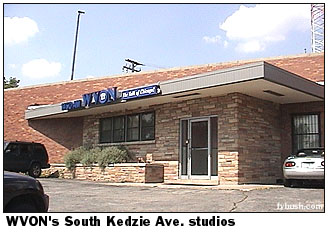 The
Cicero-licensed 1450 has actually gone from share-time to single
station to back again, beginning in the twenties on 1420 kHz
as WHFC ("Hotel Flanders, Chicago"), WKBI and WEHS.
WHFC consolidated the others into a single license by 1936, and
in 1963 was sold and became black-owned WVON, "Voice of
the Negro." The
Cicero-licensed 1450 has actually gone from share-time to single
station to back again, beginning in the twenties on 1420 kHz
as WHFC ("Hotel Flanders, Chicago"), WKBI and WEHS.
WHFC consolidated the others into a single license by 1936, and
in 1963 was sold and became black-owned WVON, "Voice of
the Negro."
In 1975, WVON's owners bought the more powerful 1390 signal,
then WNUS (ex-WGES, WYNR), and moved WVON's operations down the
dial. With 1450 suddenly open (remember, this was pre-duopoly),
the FCC recruited classical WFMT-FM (98.7) to operate the frequency
while it took applications for the open channel.
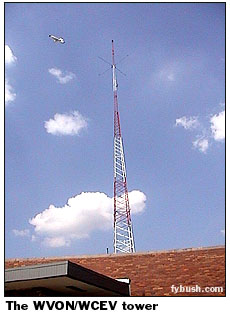 In
1978, WFMT(AM) gave way to two new licensees sharing 1450. WCEV,
"Chicagoland's Ethnic Voice," did foreign-language
programming half the day, while WXOL catered to the urban audience
the other half, operating from the shared 1450 transmitter site
and former WVON studios at 3350 South Kedzie Ave. In
1978, WFMT(AM) gave way to two new licensees sharing 1450. WCEV,
"Chicagoland's Ethnic Voice," did foreign-language
programming half the day, while WXOL catered to the urban audience
the other half, operating from the shared 1450 transmitter site
and former WVON studios at 3350 South Kedzie Ave.
The circle was closed in the mid-eighties, when the "new"
WVON on 1390 changed calls to WGCI(AM), thus freeing WXOL to
change its calls back to...WVON, which is what it remains to
this day.
By the way, take a careful look near the top of the tower:
those four arms support the dipole wires that are the actual
1450 antenna shared by WVON and WCEV.
From here, we move a bit north again as we head west out I-290
towards the pretty urban suburb of Oak Park.
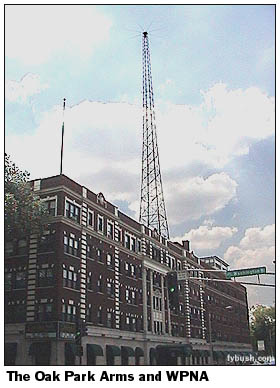 It's here, at 408
S. Oak Park Ave., at the corner of Washington Street, that we
find the old Oak Park Arms apartment building, lately reborn
as a senior citizen housing complex. It's here, at 408
S. Oak Park Ave., at the corner of Washington Street, that we
find the old Oak Park Arms apartment building, lately reborn
as a senior citizen housing complex.
Big deal? Ah...but the Oak Park Arms had its own radio station
as far back as the twenties, operating from a little penthouse
accessible through a narrow steep stairwell in the building.
When so many other "little" stations folded in the
decades that followed, WOPA just kept going, sending out its
1490 kHz signal from a top-hatted antenna on the building's roof
and even adding an FM signal on 102.7.
Even as late as the 1980s, with its calls changed to WBMX(AM)
to match its FM partner, 1490 remained at the Oak Park Arms.
And when the FM was sold, becoming today's WVAZ, little AM
1490 still remained atop the Oak Park Arms. Today it's all Polish,
under the calls WPNA, but the studios are still up there on the
roof (look just above the "Washington St." mast arm
towards the right side of the fram and you can see them!)
From here, we said farewell to Chicago (leaving South Side
sites like WRDZ 1300, WNTD 950's separate day and night sites,
WLXX 1200 and the new WNWI 1080 for another day in the Windy
City), bound for Rockford, Dubuque and the Quad Cities. We'll
show you those in part three, coming to fybush.com August
15.
|
